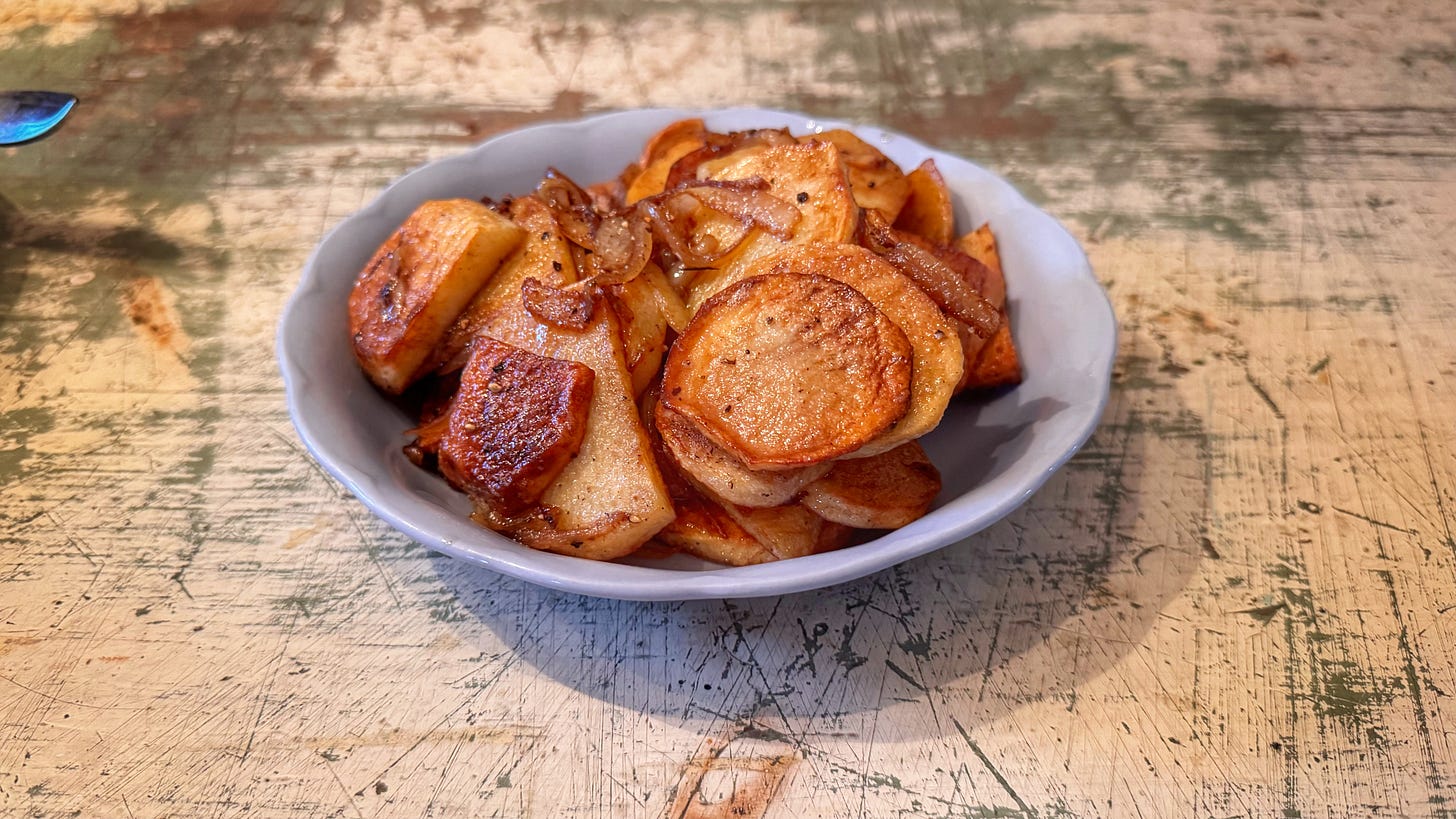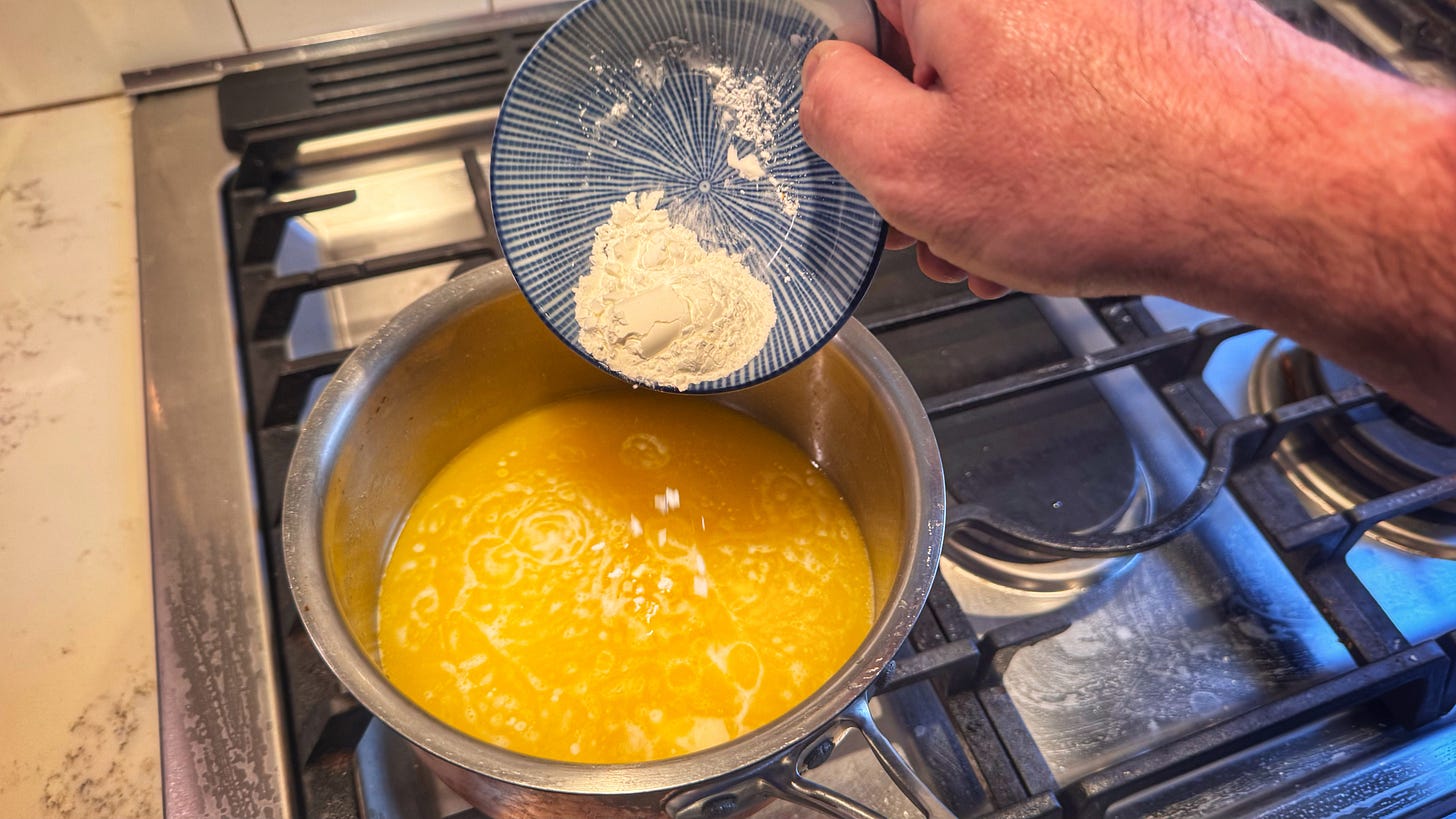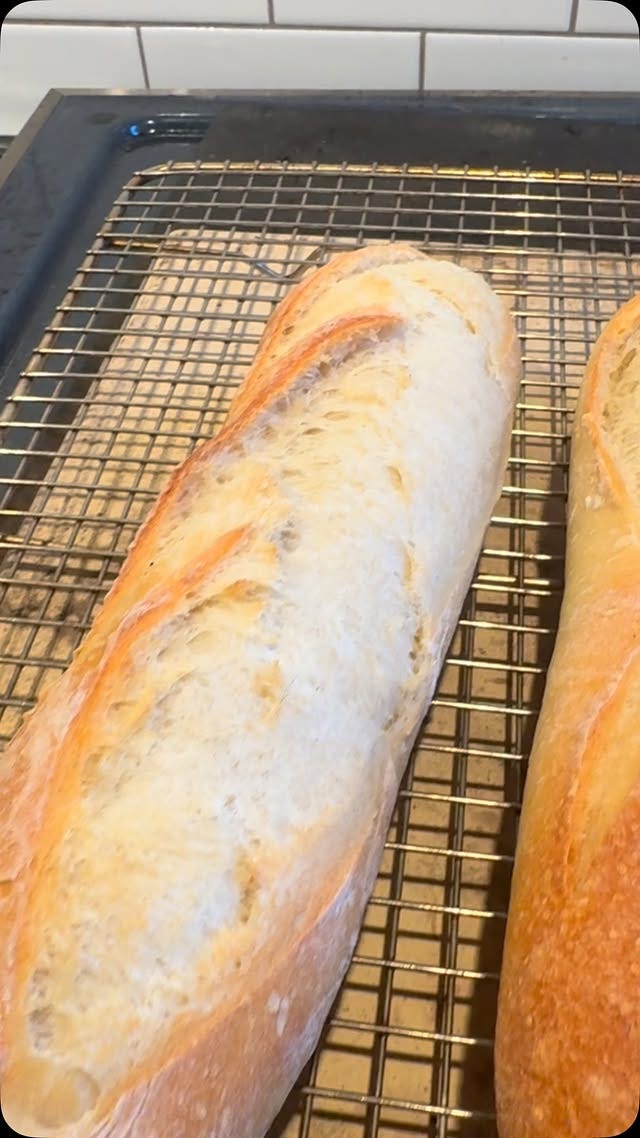62. Allow Me to Clarify
How I learned from a mistake
A few weeks ago I had another hankering for Lyonnaise potatoes. It happens from time to time, mostly when I’m reminded of Midnight Run. 1
Fortunately I was not penniless and walking down the side of a road outside Channing, Texas,2 so I could do something about it. I found a recipe online that called for frying the potatoes and onion in clarified butter. Clarified butter is butter that has been heated until all of the water it contains cooks off and the milk solids separate and get skimmed off as they rise to the surface, leaving only pure butterfat. This gives it a higher smoke point than normal butter, which in turn means that the potatoes can be cooked hotter and become crispier. And it contributes a subtle, buttery flavour you don’t get when cooking with oil.
Clarifying butter requires two simple things: time and attention.345 It can take up to a half hour to remove all of the water and milk solids. And if you’re not paying close attention, the milk solids can brown before you skim them off, turning everything brown instead of the bright, golden colour you’re aiming for. And these two simple things conspired to work against me: it took enough time that I got distracted and stopped paying attention to the pot. By the time I remembered to look again, I had very brown butter.6
It was beyond a brown butter and more like a beurre noir. Its dark, nutty, and slightly bitter flavour stole much of the spotlight from the potatoes and onions. Not that it still wasn’t delicious, but wasn’t a proper Lyonnaise potatoes.
When I fail at something in the kitchen, which happens on occasion, I usually research what I can do differently next time.7 Since it was the length of the process that did me in last time, a post on thekitchn.com8 claiming you could clarify butter in just 5 minutes got my attention. It uses cornstarch rather than long heating to draw the milk solids out of solution with the fat.9 I had to give it a go.
Fortunately, butter was on sale during my next weekly shopping trip, so I grabbed an extra pound and went home to see if the article’s promise was true.
I chopped my butter into small cubes and measured out three teaspoons of cornstarch. The butter went into a pot and the pot went over medium-low heat.
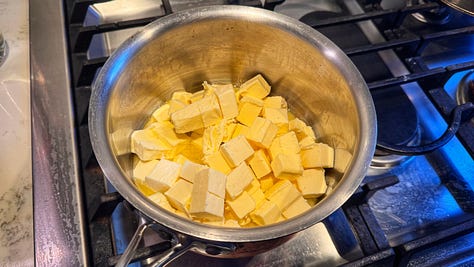
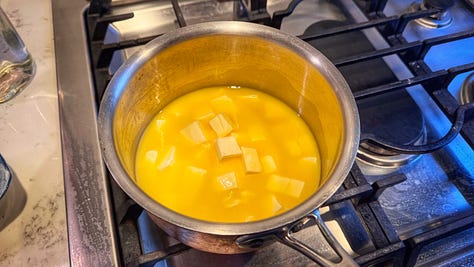
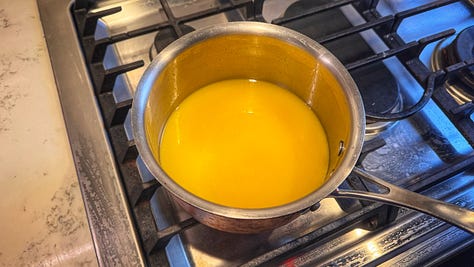
It melted and eventually began to gently simmer, with the surface slightly bubbling. This was the sign it was time for the cornstarch, which I added and then whisked to combine.
As promised in the recipe, the butter foamed up quite a bit. But this is where my experience diverged from what thekitchn promised. After adding the cornstarch, their recipe says, “Continue to simmer until the mixture stops foaming, about 1 minute.” My mixture, however, did not stop foaming during my ten minutes of whisking. At least, since I was whisking, I couldn’t wander away and leave it to brown again.10 After ten minutes, I decided that the cornstarch should have worked its magic by then and moved on to the next step: removing the pan from the heat.
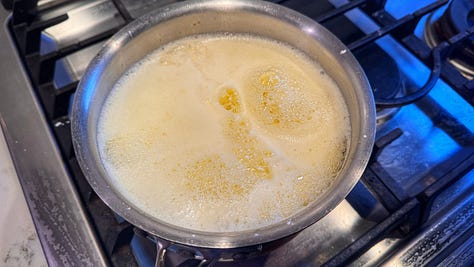

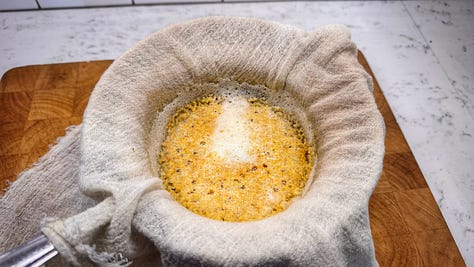
I lined a fine-mesh sieve with two layers of cheesecloth and poured in my mixture. What was left was a thick, semi-gooey slurry of cornstarch and milk solids. Lifting up the sieve… success! Beautiful, golden, and perfectly clear butterfat, ready to melt onions and crisp potatoes the next time my mind wanders and I happen to think about Midnight Run again.11
What I’m consuming…
Bread books—If you follow me on Instagram (why aren’t you following me on Instagram?), or, more likely, if you’ve read the past few issues of this very newsletter, you’ve seen that I have been on a bread making journey.
There have been some successes and some failures and, just as I wrote up top, that has spurred me to do more research. Stacked beside me on the table are Flour Water Salt Yeast by Ken Forkish and Peter Reinhart’s Artisan Breads Every Day, and the James Beard- and AICP-award winning The Bread Baker’s Apprentice, both by Peter Reinhart.
Hopefully my loaves will start becoming more consistent and regular-shaped as I make my way through them. So far, I’ve enjoyed digging into the technical ABCs in The Bread Baker’s Apprentice, as Reinhart outlines his 12-stage grand unified theory of breadmaking.12
What’s on the menu…
Accidental calzone—From December until the end of March, the cold room under our front porch is a walk-in fridge, give or take a few degrees. I wouldn’t store meat or dairy down there, but it comes in handy for storing overly large vegetables or batches of New York-style pizza dough that have to cold ferment for three days to develop flavour and gluten. It’s one reason I don’t make NY-style pizza at other times of the year: our normal fridge doesn’t have room for the dough and the containers they proof in. With cold weather continuing into mid-April, I figured I had one more NY-style session remaining; I was very, very wrong. The cold room was nowhere nearly cold enough, causing the dough after three days to be extremely over-proofed. Removing the first dough from its container, it was a floppy, sticky, weak mess. When I tried to stretch it to size, it tore immediately. It was clear that this mass of dough was not going to be a pizza. But that didn’t mean it wasn’t going to be something. I gave up on stretching and sealed the tears.
Then I placed all of the planned toppings on half the dough, gently folded the other half over and sealed the open sides: accidental calzone! Because of its thickness, it took a little while longer to bake, but it was very tasty. Almost good enough to make it on purpose one day!
One Last Thing: When I started my video series Just Add Celebs, I always had the faint hope that I could get one of the celebrities in my various cookbooks to make their recipe with me. I saw in The Globe and Mail recently that Liona Boyd, the classical guitarist and Pierre Trudeau paramour, had moved back to Canada and had an album to promote and it seemed like the perfect storm.
But I need your help. If you’re on Instagram, please please post and tag @lionaboydmusic that you would like her to appear on Just Add Celebs!
…which can also create a hankering for chorizo and eggs.
Or at least I’m not walking down a road outside Channing, Texas, at any rate.
And butter! Clarifying butter requires three simple things.
And a pot! Clarifying butter requires four simple things.
And a stove! Clarifying butter requires five simple things.
You could call it ghee, which is clarified butter that has had its milk solids cooked a bit before they’re removed, but what I had was half a Pantone book away from the colour of any ghee I’ve seen.
Beyond the obvious remedy of “Keep your eyes on the butter, dumbass.”
thekitchn in turn gives credit for the idea to Cook’s Illustrated. (It’s paywalled, but if you subscribe, have a look and tell me what it says.)
Which is reminiscent of using an egg white raft to clarify a stock or gelatin to clean frying oil for reuse.
I just rewatched the video that accompanies thekitchn’s recipe. I think I may have mistaken, “continue simmering” for “continue whisking.” Whoops! Mabye that’s why mine kept foaming.
Why aren’t you popular with the Chicago Police Department?




